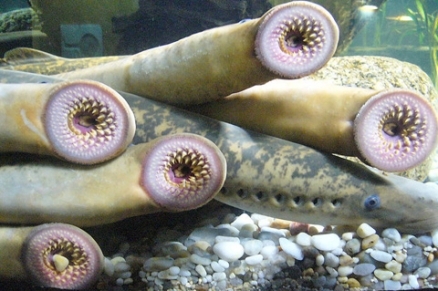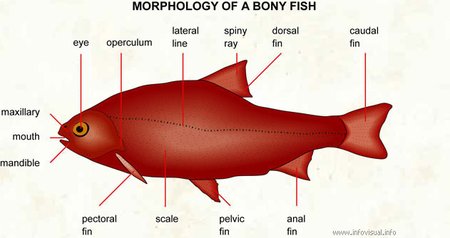Fish (Biodiversity)
Contents
Fish
Fish are any of a large group of cold-blooded, finned aquatic vertebrates. Fish are generally scaled and respire by passing water over gills.There are three maingroups- of modern fishes(1) Agnatha, the primitive jawless fish (e.g., Lampreys and Hagfish) (2) Chondrichthyes, the jawed fish with cartilaginous skeletons (e.g., Sharks, Rays, and Rat-Fishes), and (3) Osteichthyes, fish with bony skeletons (e.g., Lungfish, Trout, Bass, Salmon, Perch, and Parrot Fish)
Species Richness, Distribution and Ecology
Worldwide, there are over 25,000 species of fish, comprising more than 50% of all vertebrate species. The diversityis partially due to their long evolutionary history. Fish originated 480 miliion years ago and modern groups of fishes have been around for about 400 millions years. Fish evolved in freshwater; the chondrichthyes moved to the sea early in evolution, while the bony fishes went through most of their evolution in fresh water and spread to the seas at a much later period. Although 97% of the water on earth is saltwater, only 58% of fish species alive today are marine. The large fraction of freshwater fishes probably is due to the fact that freshwater species are often found in isolated bodies of water which increases opportunities for speciation.
Fish are the dominant free swimming animals of the seas. The structure of a fish body is designed for ease of movement. This ability to move about easily, without relying on water currents to carry them about, has enabled fishes to exploit most parts of the world's oceans, and this is reflected in an extraordinary variety of sizes and shapes. Fish are found in both fresh and salt water worldwide. Fish come in all shapes and sizes, some are free swimming, while others rest on the bottom of the sea. Fish fill a variety of ecological niches and obtain their food in a wide variety of ways.
Morphology
Fishes are well adapted to the challenges produced by the aquatic environment. Because water has such high density, most fishes are neutrally buoyant. Thus, they are able to float relatively effortlessly in the water column without a great expenditure of energy. In addition, greater thrust can be produced by pushing against water than by pushing against air, which allows for fish to move through the water by swimming. A large proportion of the muscle mass of a fish is devoted to pushing the body and fins against the water to produce the thrust required to move the individual through the water. However, the higher density and lower compressibility of water creates drag for organisms moving through water. Fishes have responded to this problem by a developing a streamlined shape which reduces drag.
Physiology
Living in the aquatic environment also affects things happening inside the body as well. The internal concentration of solutes (dissolved particles) of cells of most fishes is about one third as high as in sea water. Because fish cells contain lower solute concentration than sea water and higher solute concentration than most freshwater environments, fishes face different problems when living in marine (problem is taking up too much salt and losing too much water) versus freshwater (the problem is losing too much salt and gaining too much water). Fishes use a variety of strategies to maintain proper solute concentration in their cells which generally involves some expenditure of energy.
Growth
Most fishes have indeterminate growth, which means that they continue growing throughout their liives. Thus, larger fishes are usually older. The growth rate of fishes can be influenced by a variety of factors including temperature, dissolved oxygen, salinity, competition with other species, and food availability of quality. Most species have a temperature at which growth is maximized so that growth is reduced in cooler or warmer temperatures. The growth of many species varies seasonally as both food availability and temperature vary.
Reproduction
Fishes have a variety of reproductive strategies. Just like in mammals, sexual reproductionof fishes involves the production of sperm by males and eggs by females. However, unlike humans, it is possible for some fishes to produce both eggs and sperm in the same individuals (hermaphrodite) and other species change sexes during their lifetime. Generally fertilization of the eggs occurs outside the body of the female (external fertilization); the female either deposits eggs on the substrate, in a nest, or in the water column and then a male, or males, deposits sperm on the eggs so that they can fertilize them. Often once the eggs are fertilized, they are left to develop on their own. However, in some species a parent, usually the male, provides care for the eggs by protecting them from predators, fanning the eggs to maintain a flow of oxygen across the eggs, and removing fallen debris from the eggs. In some fishes (e.g., the sea-horses) male cares for the young in a specialized pouch and in others (e.g., some cichlids and cardinal fishes) parents care for the offspring in their mouths (mouth brooders). Other species give birth to live offspring (vivipary) which can be advantageous because the offspring receive more care from their mother and are not exposed to predation. For this to happen fertilization must occur internally. Because fishes lack a penis, they have innovated a variety of structures to transfer sperm from the male inside the body of the female.
Further Reading
- D.H. Evans and J.B. Claiborne (eds.) 2005. The Physiology of Fishes, 3rd Edition.. CRC Press.
- Marine Biology Learning Center Odyssey Expeditions
- Robert B. Moeller Jr. 2011. Biology of Fish Ciclid-forum.com
- G. Lecointre & H. Le Guyader, 2007, The Tree of Life: A Phylogenetic Classification, Harvard University Press Reference Library
- A.G. Zapata, A. Chiba and A. Vara. 1966. Cells and tissues of the immune system of fish. In: The Fish Immune System: Organism, Pathogen and Environment. Fish Immunology Series. (eds. G. Iwama and T.Nakanishi,), New York, Academic Press. pp. 1–55.

